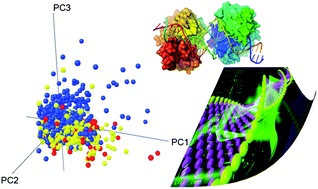Epigenetic relevant chemical space: a chemoinformatic characterization of inhibitors of DNA methyltransferases†
Abstract
DNA methylation is an epigenetic mechanism mediated by a family of proteins called DNA methyltransferases (DNMTs). The misregulation of the covalent modification of DNA through the addition of a methyl group at the carbon-5 position of cytosine residues is common in many diseases including cancer. Recent advances in synthetic and screening technologies for DNMT inhibitors (DNMTi) have made significant contributions to uncover promising candidates for epigenetic drug discovery. The structure–activity information, not available a few years ago, is being collected in public molecular databases. However, no systematic chemoinformatic studies that analyze the structural diversity and coverage of the chemical space of DNMTi with experimental activity have been discussed thus far. Herein, we report the assembly and curation of a molecular database of small-molecule DNMTi with a special focus on inhibitors of DNMT1. The compound collection was characterized using a comprehensive chemoinformatic approach that involved physicochemical properties, structural fingerprints, and molecular scaffolds. The availability of activity information enabled us to conduct chemotype enrichment analysis and suggest potential privileged epigenetic scaffolds. The structures of inhibitors of DNMT1 were compared to drugs approved for clinical use, compounds in clinical trials, a commercial screening library focused on epigenetic targets, and a general screening collection. The results of this work provided key insights to start characterizing the epigenetic relevant chemical space.


 Please wait while we load your content...
Please wait while we load your content...